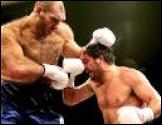Lamont Russell: Sporting Life
Sporting Life
by Lamont Russell
 For more than a decade, heavyweight
boxing has been in decline and unfortunately, the victory
last month by Ukraine’s Wladimir Klitschko over the Uzbek
fighter Ruslan Chaguev in front of 61,000 fight fans in
Germany, will do little to arrest the slide. Which is a real
shame, since Klitschko’s win sealed his status as world
champion, with only his big brother Vitali having anything
like the same credentials. Moreover, Klitschko’s win
maintained the dominance of the current crop of boxing
behomeths over ordinary sized heavyweights.
For more than a decade, heavyweight
boxing has been in decline and unfortunately, the victory
last month by Ukraine’s Wladimir Klitschko over the Uzbek
fighter Ruslan Chaguev in front of 61,000 fight fans in
Germany, will do little to arrest the slide. Which is a real
shame, since Klitschko’s win sealed his status as world
champion, with only his big brother Vitali having anything
like the same credentials. Moreover, Klitschko’s win
maintained the dominance of the current crop of boxing
behomeths over ordinary sized heavyweights.
We’ve had huge fighters in this division before, but they’ve generally been regarded as freaks. Primo Carnera in the 1930s for instance, was roughly the same size as the Klitschkos ( about 6 feet five and a half inches, or 1.97m) and weighed 270 pounds, but he had only minimal boxing skills. Wladimir Klitschko though weighs 245 pounds of muscle, and has the most effective left jab in the heavyweight ranks. The big guys now have good boxing skills as well as the weight, height and reach advantages.
The borderline for the heavyweight division is 201 pounds. A few months ago, the American boxing writer Doveen Linder noted the rise of the monster heavyweights and tried to argue for the creation of a separate, super heavyweight division. On the grounds that these days, a capable heavyweight of what was formerly seen as normal size – say, Chaguev at 1.89m and 225 pounds, or Britain’s David Haye at the same size and 215 pounds – has little chance against either of the Klitschkos.
There are even bigger guys out there. Nikolai Valuev aka The Beast from the East, stands 2.13m ( that’s seven feet one for old school types) and weighs 310 pounds. How do these current big guys match up, size wise, against the ring warriors of the past ? Little Rocky Marciano – at 180 - 190 pounds and only a 1.70m reach – would have had his work cut out getting anywhere near to either Klitschko or to Lennox Lewis, who had a reach of 2.13m. As Linder points out, Joe Louis, Mike Tyson and Muhammad Ali all fought within the 210 to 225 pound range.
 Size and weight will
not always of course, triumph over skill. Last year Chaguev
beat the gigantic Valuev. Conversely, Lennox Lewis – who
was as tall as the Klitschkos, had an extraordinarily long
reach and brilliant defensive skills – still got himself
knocked out by the likes of Hasim Rahman and Oliver McCall.
Yes, it may (literally) be an uphill battle, but talent can
triumph over size, at least some of the time. For now, the
telling argument against creating a separate super
heavyweight division is that the talent is so spread so
thinly anywhere in the realms above 200 pounds, that the
last thing boxing needs is to start splitting up its
options.
Size and weight will
not always of course, triumph over skill. Last year Chaguev
beat the gigantic Valuev. Conversely, Lennox Lewis – who
was as tall as the Klitschkos, had an extraordinarily long
reach and brilliant defensive skills – still got himself
knocked out by the likes of Hasim Rahman and Oliver McCall.
Yes, it may (literally) be an uphill battle, but talent can
triumph over size, at least some of the time. For now, the
telling argument against creating a separate super
heavyweight division is that the talent is so spread so
thinly anywhere in the realms above 200 pounds, that the
last thing boxing needs is to start splitting up its
options.
The woes of the heavyweight division are certainly not being reflected lower down in the weight divisions. In fact, at lightweight to welterweight in particular, boxing is currently going through a golden era. It has happened before. During the 1980s, Sugar Ray Leonard, Tommy Hearns and Marvin Hagler were far, far more exciting than anything that the bigger guys had to offer. For that reason, the postponement ( through a rib cartilage injury ) of this month’s scheduled comeback fight by former champion Floyd Mayweather has been a genuine blow to the sport.
 If Mayweather had
managed to get past Juan Manuel Marquez in that fight
originally scheduled for July 18, this was expected to clear
the decks for a match-up between Mayweather and the best
pound-for-pound fighter in the world today, Manny Pacquiao
of the Philippines. Supposedlky, Mayweather vs Marquez is
now due sometime in September.
If Mayweather had
managed to get past Juan Manuel Marquez in that fight
originally scheduled for July 18, this was expected to clear
the decks for a match-up between Mayweather and the best
pound-for-pound fighter in the world today, Manny Pacquiao
of the Philippines. Supposedlky, Mayweather vs Marquez is
now due sometime in September.
Unfortunately, the machinations that are swirling around a match-up between Mayweather and Pacquiao are starting to feel like the shenanigans normally associated with the heavyweights. First, there has been some doubt over whether Mayweather’s rib injury in training was genuine. Second, Mayweather’s money demands for fighting Pacquiao – who is the most sought after fighter in the sport today, and hardly needing to compromise – are said to be prohibitive, at this stage at least.
That’s quite difficult to understand, given Mayweather’s well publicised financial problems, and the ease with which Pacquiao can find lucrative paydays elsewhere – say, by fighting Shane Mosley. All this flak is being laid down even before the arguments begin as to which weight limit should apply to any encounter between the two fighters. ( Both Mayweather and Pacquiao have been world champions in five different weight divisions.)
Keep this up for much longer, and Mayweather is going to look as if he’s seeking any excuse to avoid his date with Pacquiao. That’s hardly a good way for a formerly great fighter – last year, Mayweather was listed among the top 50 boxers of all time - to be remembered. As usual, boxing is being its own worst enemy – by Lamont Russell
Lamont Russell is a writer based in Wellington


 Binoy Kampmark: Israel’s Anti-UNRWA Campaign Falls Flat
Binoy Kampmark: Israel’s Anti-UNRWA Campaign Falls Flat Peter Dunne: Luxon Gets Out His Butcher's Knife - Briefly
Peter Dunne: Luxon Gets Out His Butcher's Knife - Briefly Binoy Kampmark: Warring Against Encryption, Australia Is Coming For Your Communications
Binoy Kampmark: Warring Against Encryption, Australia Is Coming For Your Communications Gordon Campbell: On Fast Track Powers, Media Woes And The Tiktok Ban
Gordon Campbell: On Fast Track Powers, Media Woes And The Tiktok Ban Binoy Kampmark: Censorship Wars, Elon Musk, Safety Commissioners And Violent Content
Binoy Kampmark: Censorship Wars, Elon Musk, Safety Commissioners And Violent Content Gordon Campbell: On The Public Sector Carnage, And Misogyny As Terrorism
Gordon Campbell: On The Public Sector Carnage, And Misogyny As Terrorism